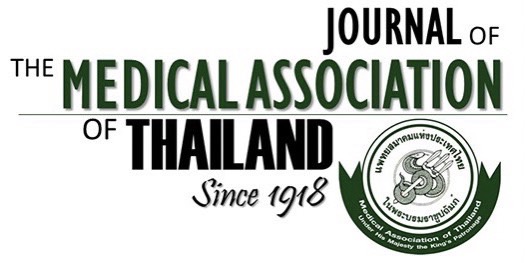Endoprosthetic Reconstruction for Malignant Bone and Soft-Tissue Tumors
Apichat Asavamongkolkul MD*, Saranatra Waikakul MD*, Rapin Phimolsarnti MD*, Piya Kiatisevi MD**, Prasert Wangsaturaka MD*
Affiliation : * Department of Orthopedic Surgery, Faculty of Medicine, Siriraj Hospital, Mahidol University ** Orthopedic Institute, Lerdsin Hospital
Background : Nowadays, the results of the management of malignant bone and soft-tissue tumors have been
dramatically improved because of the advance in imaging, chemotherapy, radiation therapy, and surgical
techniques. Patients can have longer survival times with limb-salvage surgery. Several techniques of recon-
struction have been advocated and gained more popularity following malignant tumor resection by using
allograft, tumor prostheses, composite allograft prosthesis, or arthrodesis.
Objective : To report the preliminary results of 32 endoprosthetic reconstructions following malignant bone
and soft-tissue tumor resection. The oncologic results, functional outcomes, and complications from the sur-
gery were assessed in the present study.
Materials and Methods : Since September 1988, the authors have performed 188 limb-salvage surgical opera-
tions for the treatment of musculoskeletal tumors at Siriraj Hospital. From March 1994 to July 2006, 32
endoprosthetic reconstructions were performed on 30 patients following malignant bone or soft-tissue tumor
removal. There were 16 males and 14 females with a mean age of 28 years (range 10-73). The diagnosis was
conventional osteosarcoma in 16 patients, parosteal osteosarcoma in two patients, chondrosarcoma in two
patients, leiomyosarcoma in two patients, failed allograft in two patients and one patient each of periosteal
osteosarcoma, Ewing’s sarcoma, Gorham’s disease, synovial sarcoma, malignant fibrous histiocytoma, meta-
static renal cell carcinoma, and prosthetic loosening. Wide excision was performed with a mean length of 18.5
cm (range 10-41). Five proximal femurs, 17 distal femurs, 1 total femur, 3 proximal tibias, 1 intercalary tibia,
4 proximal humerus and 1 distal humerus were used for reconstruction. Modular replacement systems (MRS,
Stryker/Howmedica/Osteonics) were the most common prostheses used in the present series.
Results : The mean follow-up time was 26 months (range 6-128.7). Sixteen patients are continuously free of the
disease, two are alive with the disease, two had no evidence of the disease, nine died of the disease, and one
patient died from complication of hypertension. The mean Musculoskeletal Tumor Society functional analysis
for upper extremity reconstruction was 93% (range 86.7-100) and for lower extremity was 89% (range 63.3-
100). Two patients (6.7%) were determined to be a failure. Revision due to aseptic loosening was performed
in one patient (3.3%) and one hip disarticulation was done related to local recurrence (3.3%). One patient
with sciatic nerve palsy and two seromas was found and successfully treated in the present study.
Conclusion : Endoprosthetic reconstruction could yield satisfactory results as a wide excision and limb-
salvage for patients with malignant bone and soft-tissue tumors. Most patients in the present report had good
to excellent functions following surgery and few complications occurred in the present report.
Keywords : Limb-salvage surgery, Endoprosthetic reconstruction, Malignant bone tumor, Malignant soft- tissue tumor



